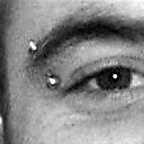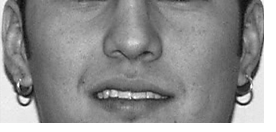The NCAA News - News and Features
The NCAA News -- July 19, 1999
Pierced parts
Trends in body piercing present committees with potential rules loopholes
BY GARY T. BROWN
STAFF WRITER
You can't control what you can't see.
That's the motto for NCAA playing rules committees when it comes to body piercing. And though there are various safety concerns with this growing trend in intercollegiate sports, there's no movement afoot to go looking for it, either.
 Perhaps calling it a trend is an exaggeration -- tongue studs and navel rings aren't as prevalent as tattoos, for instance. But unlike tattoos, tongue studs and navel rings could cause injury in competition. And if that's the case, why shouldn't they be regulated?
Perhaps calling it a trend is an exaggeration -- tongue studs and navel rings aren't as prevalent as tattoos, for instance. But unlike tattoos, tongue studs and navel rings could cause injury in competition. And if that's the case, why shouldn't they be regulated?
Jewelry in fact is regulated in most sports for which the NCAA writes rules. Most ban it completely, from bracelets and necklaces to watches and earrings. But for contemporary college students, jewelry has entered a whole new realm: tongue studs, navel rings, eyebrow loops, toe rings, nipple rings -- an entire gamut of "body art." And some of these adornments are "loopholes" when it comes to playing rules jurisdiction because of their location.
One softball coach didn't know her catcher had a tongue stud until the player was having it treated by an athletic trainer. A volleyball player caused the start of a match to be delayed when she was whisked off the court by an official who detected an eyebrow loop. A basketball player successfully hid a tongue stud from her coach simply because she didn't play much.
Are those players at risk?
"If it's detected, you have to take it out or sit down," said Marcy Weston, coordinator of officials for women's basketball. "But if you're unaware of it, you can't enforce it."
Weston said making the call on something visible is easy.
But the challenge is whether officials should start looking for stuff -- whether the search is asked for or not.
"The referees are compelled to deal with anything visible," she said. "But the tongue stud has created some interesting situations because people are basically telling on each other, telling the ref before the game that so and so has a pierced tongue.
 And the refs are saying, 'Hey I'm not asking them to see it and if I don't see it I'm staying away from it.' "
And the refs are saying, 'Hey I'm not asking them to see it and if I don't see it I'm staying away from it.' "
Low risk, high liability
Body piercing is more of an issue for college students than for college student-athletes.
Most student-athletes are aware of the risks involved with not removing those items before competition.
Some, however, don't see the risk because they believe as long as the item is covered, there's no harm.
"We've had some questions about it and most are looking at it as a personal-statement thing. 'What's wrong with that?' they say. 'We have tattoos, why not piercing?' " said Dee Abrahamson, the NCAA Softball Rules Committee's secretary-rules editor. "From a rules standpoint, it's just a matter of safety. I talked with a coach recently about two players who had been hit in the eyes with batted balls, and we talked about how it's a good thing neither was wearing an eyebrow ring."
Abrahamson said almost any rules person will say they don't want people in hindsight regretting that something was allowed that caused an injury.
"It's just easier to say don't do it," she said. "But as for tongues, navels and nipples, does that present a problem if it's not exposed? I know of a male swimmer who has pierced nipples who says it's not a problem because the shirt is on in the weight room and when he's in the pool it's not an issue."
Cliff McCrath, secretary-rules editor for the NCAA Men's and Women's Soccer Rules Committee, said there is as fine a line between cultural expression and safety as there is between practical enforcement and overreaction. Toeing that line, he said, can be delicate.
"There's a cultural reaction that coaches have when they suddenly realize that one of their players has a tongue stud or something," he said. "That causes a long enough pause for the coach to say to himself, 'If that player swallows his or her tongue -- and we don't have a rule that prohibits this -- then that player also could cut his or her throat.' Is that sensible?
"On the other hand, we've taken a stance against all that stuff in college soccer because somewhere there's a remote possibility that a player with a post in his nose could collide with another player who has a post in his eyebrow -- that possibility cries out for some prohibition. To that extent, you're not speaking to a cultural issue or freedom of someone's personal development, but of a safety factor. It's a good rule to not allow jewelry in a game where bad things happen even without it."
But McCrath said his committee wasn't going to go looking for tongue studs, either.
"We're not going to make a rule that says everyone has to stick their tongues out," he said. "In fact, we have a rule now that says if you do that you get a red card."
Awkward spot
Bryan W. Smith, team physician at the University of North Carolina, Chapel Hill, and incoming chair of the NCAA Committee on Competitive Safeguards and Medical Aspects of Sports, said that body piercing, while not an epidemic, has grown in popularity within the college environment.
"We certainly see many more people here at North Carolina with body piercing than we did five years ago," he said. "Back when I was at UCLA in 1991, we could count the number of people who had body piercing on one hand -- now it's exponentially increased. And certain places to pierce are much more common than others. The tongue is still a little uncommon, at least here. But you're seeing a lot more navels and eyebrows and different places on the ear. And males are doing it more than in the past."
He said rules committees are in an awkward spot with this issue because of their lack of ability to enforce a rule against "hidden" piercing. "Any time you make a rule, you have to at least imply that you're going to enforce it," he said.
Most rules committee members say it's an issue that perhaps should be worked out between players and their coaches. The problem there is that most coaches are part of a generation that's likely to react against body piercing as a way of personal expression.
"There's a certain level of repulsion involved in almost any option that some historian would consider abnormal," McCrath said. "There's always going to be a certain segment of every culture or society that reacts against a trend. They might react with anger, fear or curiosity. But just like a lot of other things from the perspective of people in positions of authority, those moments of shock or curiosity don't last very long."
"Coaches can let student-athletes know what their personal preferences are and then the players can decide from there," Abrahamson said. "But even then, if a kid is wearing a toe ring and softball shoes, do we have the right to say, 'Gosh I think that's tacky'?"
Weston said it's best to err on the side of "don't ask" with this particular issue -- that it should be looked at by rules makers as a safety-only issue and not as an evaluation of personal expression or image.
Still, the situation lingers where a student-athlete with an undetected piece of jewelry either suffers or causes a serious injury. Can that be prevented? Again, Weston said, you can't control what you can't see.
Smith said in most cases, athletic trainers can help advise student-athletes who have chosen to adorn themselves in this manner about the risks involved in competition. And again, that's if the player chooses to confide in the athletic trainer in the first place.
"A lot of the stuff in eyebrows and ears will be taken out, so you don't have to worry too much about it," he said. "And navels and tongues still are pretty uncommon. But you typically experiment with these things as a college student. Athletic trainers and coaches try to instruct their athletes accordingly, but it's an interesting question."
And it's a question where -- at least for now -- the answers are hidden.
|